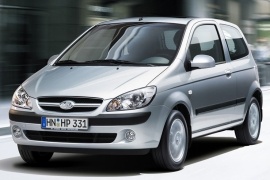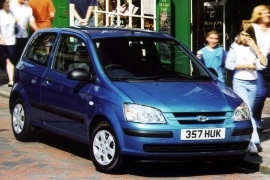HYUNDAI Getz 3 Doors Models/Series Timeline, Specifications & Photos
First production year: 2002
Engines: Gasoline, Diesel
Body style: Hatchback
The Korean carmaker introduced a mid-life cycle refresh for the small MPV Hyundai Getz in 2005 to make it more appealing to the market. It failed.
Hyundai tried to offer a vehicle that was at the mid-way between a small-class hatchback and an MPV. The result was a vehicle too big for the small segment and not as useful as a minivan. That's one of the reasons why the Getz didn't find too many buyers on the European market. Moreover, they had to battle with other carmakers in that niche market. To distinguish itself from its competitors, Hyundai offered the Getz with three or five doors.
The facelifted version featured smoothed headlights in angular style. Its short hood and raked A-pillars made room for a taller greenhouse. From the sides, the 3-door Getz featured fixed windows on the sides. Depending on the trim level, a roof-spoiler was installed on top of the tailgate.
But the biggest improvement was on the inside, where the carmaker installed a new interior with a new dashboard and instrument cluster. Hyundai chose to keep the gear stick on the floor, like in a regular hatchback. Other carmakers moved it closer to the driver and thus made more room for the center console. There was enough room for adult passengers in the back if they didn't have long legs.
In 2005, the Euro 4 pollutions norms came into force, which is one reason why Hyundai refreshed the Getz. The carmaker introduced upgraded gasoline engines and a diesel unit.
Hyundai introduced the Getz MPV in the mini segment in 2001 at the Tokyo Motor Show. The small car was available in a three-door or a five-door body style.
Depending on the market, the Hyundai Getz was also sold as the Hyundai Click or Hyundai TB.
While the MPV segment was declining, Hyundai tried to make its way into the small-sized minivans' niche market with the Getz. When it launched the vehicle, it hoped that the customers who were looking for a compact-sized vehicle would appreciate their car's interior room and the small exterior size.
Based on the same platform as the Kia Picanto and Hyundai Accent, the Getz was in the middle between a small-segment hatchback and a minivan. Its raked hood and windshield were continued by a flat roof and a vertical tailgate. The angular-looking headlights were designed in the new-edge-design style, with corner-mounted turn-signals and clear lenses.
With most small dents happening in the parking lot, Hyundai protected the Getz's bodywork with black, plastic molds on the sides and the bumpers.
Inside, due to its tall greenhouse, Hyundai's designers installed higher seats to provide better legroom for the rear passengers.
Under the hood, Hyundai installed a choice of four engines, both diesel, and gasoline-powered, all mated with a manual transmission. No automatic transmission was offered in 2002.

